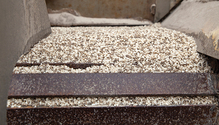
Late fall and winter are typically thought of as slow times for management of introduced warm-season perennial forages. However, there are things to do now to prepare for spring forage production that can make your life easier when forages begin to grow and things get hectic.
Have a fertilization plan
If you fertilize any of your forages, now is a good time to develop a comprehensive nutrient management program for your entire ranch. Many ranchers simply apply nitrogen to their fields. This is a good program if your soils only need nitrogen, but this is often not the case. If other nutrients are deficient, such as phosphorus or potassium, or if the soil is strongly acidic, nitrogen fertilizer will be used very inefficiently by forages and will probably be unprofitable.
Research I conducted several years ago on phosphorus-deficient soils showed that if phosphorus was not applied, nitrogen application resulted in an increase of about 5 to 10 pounds of dry matter forage per pound of actual nitrogen applied. This is a very poor efficiency. When phosphorus was applied along with the nitrogen, nitrogen efficiency improved to about 20 to 30 pounds of dry matter forage.
Bottom line: If other nutrients are deficient in the soil and you are not willing to apply them, do not apply nitrogen either because it will be inefficiently used.
The only way to determine the nutrient requirements for your field is with a good soil test. Soil testing begins with the collection of a representative soil sample. It is vital to collect enough subsamples to make up your complete sample, collect them at random, and collect them at the right depth.
If you are uncertain about how to properly collect a soil sample, the Noble Research Institute has several articles and videos on the subject. A good place to start is with the video “How to Take a Soil Sample” available at noble.org/videos/soil-sample. Put a lot of effort into proper sample collection. It is the most vital component of a soil testing program. After your samples are collected, send them to a reputable laboratory for analysis and recommendations.
Prioritize fields
While you wait for your results to come back, calculate how many cattle you can run on your ranch at various levels of fertilization. If your calculations show you don’t need to fertilize every acre, determine how many you do need to fertilize. Then, prioritize the fields to receive fertilizer in the spring.
Fertilize the most productive fields first; they are most able to convert fertilizer into forage. If you have two similarly productive fields, prioritize the one that needs less phosphorus, potassium, and/or lime to make fertilization more cost effective. Do not fertilize any highly unproductive fields. They have other reasons for being unproductive, such as shallow soil, eroded areas, salt problems, and so forth. It is usually unprofitable to fertilize such a field.
Determine weed control needs
Now is also a good time to go into the fields with a ranch map and note the abundance and types of weeds in each field. If there were a lot of weeds at a location in the preceding year, it’s a pretty good bet they will be there again in the spring.
You can use this information to your advantage in several ways. First, the weeds may be present in such low abundance that your initial survey indicates you do not need to spray some fields. This can save quite a bit of time and work in the spring, if control is not necessary.
Second, you might determine in your initial survey that weeds are unevenly distributed in some fields and only parts of fields need to be treated. Mark these areas on your map so you can compare your winter observation with the survey you will do in the spring.
Develop a herbicide strategy
Next, note the weed species in your fields. Many weeds can be controlled with herbicides that are fairly inexpensive, while others require more costly products. Mark the areas where the “expensive to control” weeds are located on your map. This information can be used to develop a tailored herbicide program that applies the optimum economic product to different fields and even to different areas of fields.
Once you have these maps complete, wait until weeds emerge in the spring. Take the maps you worked on in the winter and see if the abundance and species information for each field matches what you see when the weeds are actually present. If they do, you can begin to implement the program you developed in the winter. If there are differences between what you saw in the winter and spring, tweak the program to match what is present.
This article appeared in the November 2020 issue of Hay & Forage Grower on page 27.
Not a subscriber? Click to get the print magazine.

